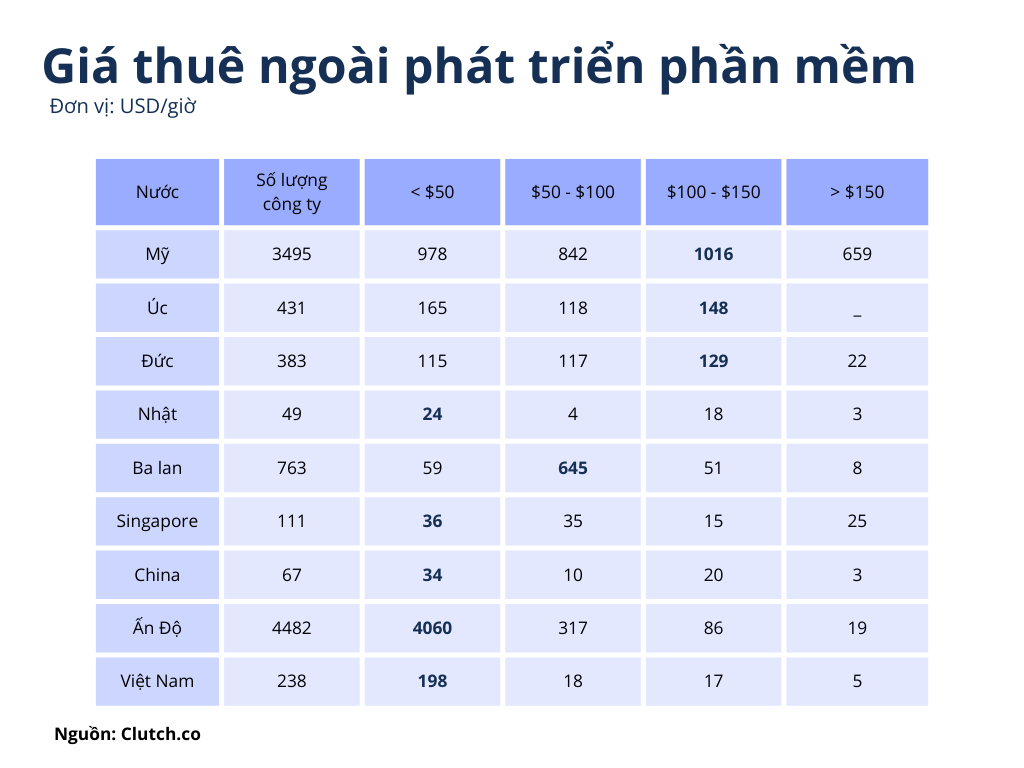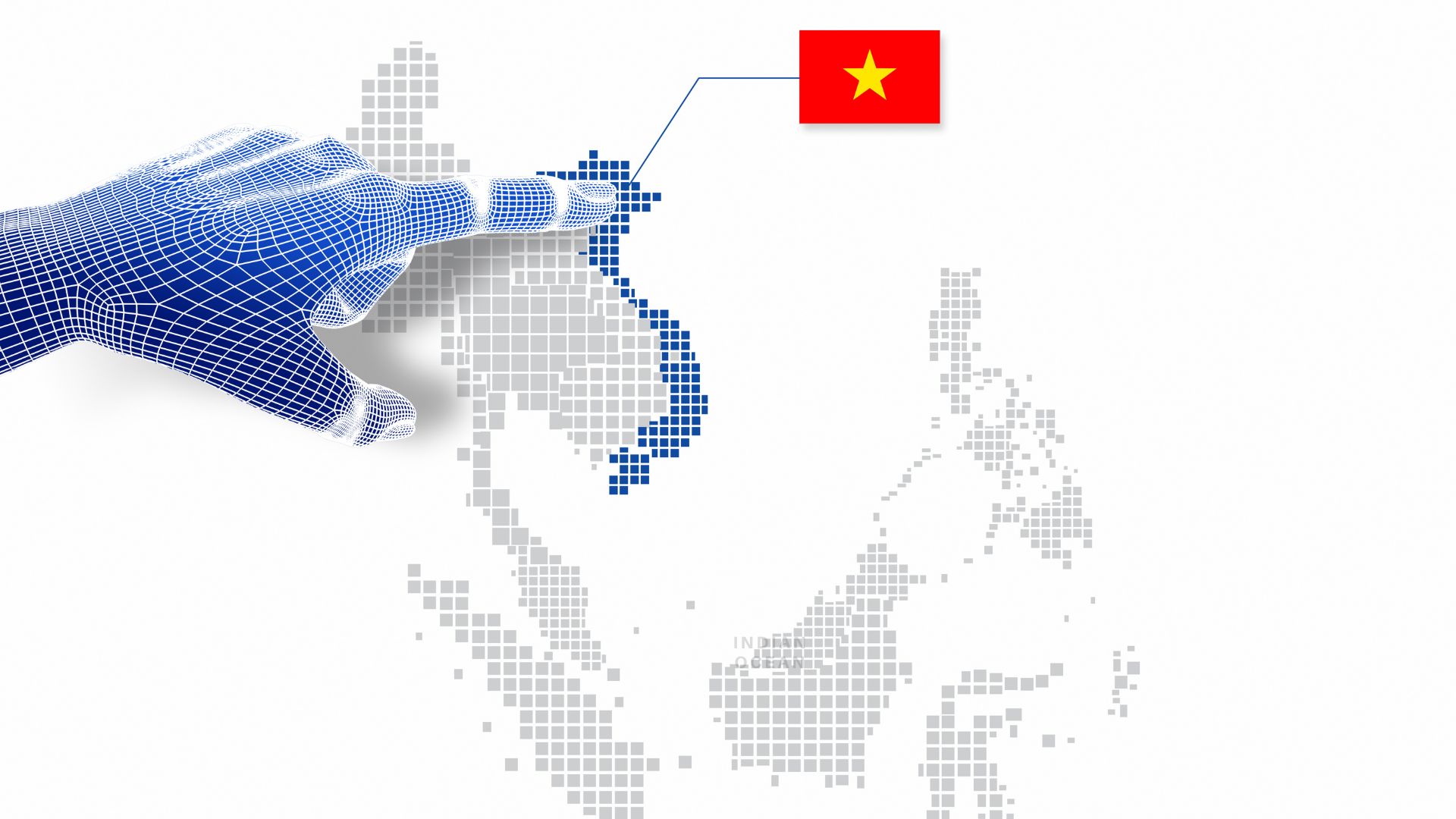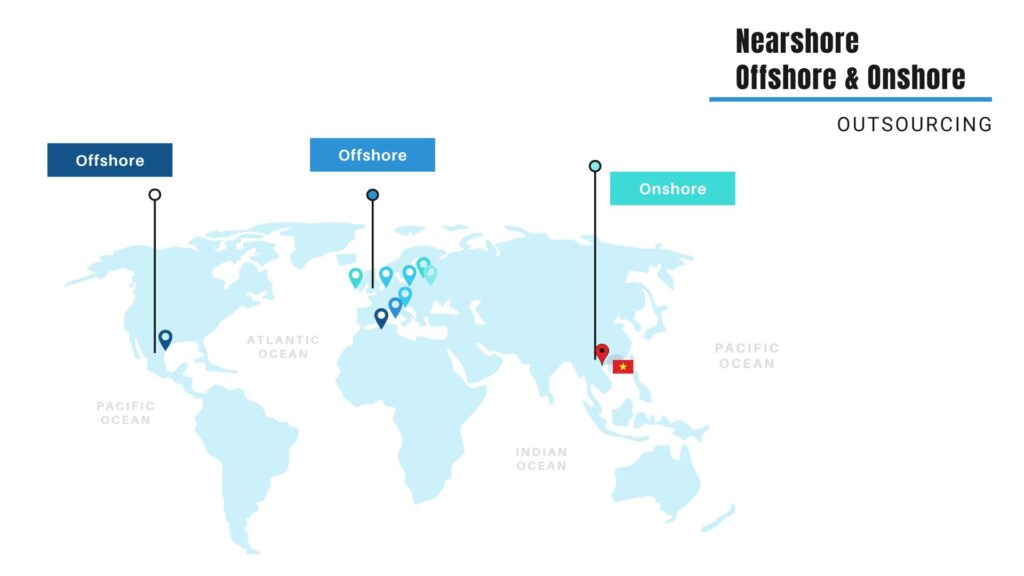Khi doanh nghiệp có nhu cầu phát triển phần mềm, họ thường phải đối mặt với quyết định chọn mô hình phát triển phần mềm nào phù hợp nhất với nhu cầu và ngân sách của mình. Ba mô hình phổ biến là Nearshore, Offshore và Onshore, mỗi mô hình đều có những ưu nhược điểm riêng về vị trí địa lý, chi phí nhân công, khả năng giao tiếp và quản lý dự án.
Trong bài viết này, chúng ta sẽ tìm hiểu sâu hơn về định nghĩa, đặc điểm và so sánh các ưu nhược điểm của mô hình Nearshore, Offshore và Onshore. Qua đó giúp doanh nghiệp đưa ra quyết định lựa chọn mô hình phát triển phần mềm phù hợp với nhu cầu kinh doanh và chiến lược phát triển sản phẩm của mình.
Khái niệm về phát triển phần mềm Nearshore, Offshore & Onshore
Nearshore
Mô hình Nearshore là mô hình phát triển phần mềm tại một quốc gia gần với quốc gia của bạn. Ví dụ, một công ty tại Mỹ có thể thuê một nhà phát triển phần mềm tại Mexico hoặc Canada để phát triển sản phẩm cho mình. Với mô hình này, bạn có thể tiết kiệm chi phí hơn so với thuê nhà phát triển trong nước, đồng thời việc giao tiếp và quản lý dự án cũng thuận lợi hơn so với thuê nhà phát triển ở các quốc gia xa xôi hơn.
Offshore
Mô hình Offshore là mô hình phát triển phần mềm tại một quốc gia xa so với quốc gia của bạn. Ví dụ, một công ty Mỹ có thể thuê một đội phát triển phần mềm tại Ấn Độ, Việt Nam, Philippines, v.v. để phát triển sản phẩm với chi phí nhân công rẻ hơn. Mô hình này giúp tiết kiệm chi phí nhưng lại khó khăn hơn trong giao tiếp và quản lý dự án.
Onshore
Mô hình Onshore là mô hình phát triển phần mềm ngay tại quốc gia của bạn. Ví dụ, một công ty tại Mỹ sẽ thuê nhà phát triển Mỹ để phát triển phần mềm cho mình. Tuy mô hình này thuận lợi cho giao tiếp và quản lý dự án, nhưng chi phí phát triển sẽ cao hơn so với hai mô hình còn lại.
Sự khác biệt giữa Gia công phần mềm Nearshore, Offshore & Onshore
1.Giá cả
Onshore thường có chi phí nhân công cao nhất do mức lương của các kỹ sư phần mềm tại các nước phát triển như Mỹ, Châu Âu, Nhật Bản,.. cao hơn so với các nước đang phát triển. Ví dụ mức lương trung bình của một lập trình viên tại Mỹ khoảng $5000-7000/tháng, trong khi tại Việt Nam chỉ khoảng $1000-1500/tháng.
Offshore có chi phí nhân công rẻ nhất, do nhân viên IT tại các nước đang phát triển thấp hơn các nước phát triển rất nhiều. Ví dụ nhân công Việt Nam, Philippines, Ấn Độ chỉ bằng 1/3 đến 1/5 so với Mỹ.
Nearshore có mức chi phí nằm giữa Onshore và Offshore, do khoảng cách địa lý gần hơn nên chi phí vận chuyển và thuế nhập khẩu thấp hơn.

2. Hệ thống pháp luật và thuế
Khoảng cách địa lý không chỉ ảnh hưởng đến chi phí mà còn tác động đến hệ thống pháp luật và thuế. Việc tìm kiếm nhà cung cấp dịch vụ ngoài nước đòi hỏi phải tìm hiểu kỹ lưỡng các quy định pháp lý cần thiết.
Với mô hình Onshore, do cùng nằm trong một quốc gia với khách hàng nên hệ thống pháp luật và chính sách thuế là hoàn toàn giống nhau. Các vấn đề về lao động, sở hữu trí tuệ, ký kết hợp đồng, giải quyết tranh chấp,…đều được điều chỉnh bởi cùng một khung pháp lý. Do đó, rủi ro pháp lý ở mức thấp nhất.
Đối với Nearshore, do khoảng cách địa lý gần nên thường có sự tương đồng lớn về hệ thống pháp luật giữa các nước. Chẳng hạn Mexico và Canada với Mỹ đều là các nền kinh tế thị trường với nền tảng pháp luật tương tự. Các hiệp định song phương, khu vực cũng tạo sự đồng nhất về chính sách thuế, hải quan. Do đó, rủi ro pháp lý ở mức thấp.
Trong khi đó, mô hình Offshore lại có sự khác biệt lớn hơn về pháp luật so với khách hàng, nhất là khi khách hàng ở các nước phát triển còn nhà cung cấp ở các nước đang phát triển. Sự khác biệt về chế độ lao động, luật sở hữu trí tuệ, thủ tục pháp lý,…tiềm ẩn nhiều rủi ro hơn. Ngoài ra, chính sách ưu đãi thuế có thể thay đổi theo thời gian. Vì vậy, rủi ro pháp lý ở mức cao nhất.
3. Khoảng cách
Khoảng cách địa lý giữa khách hàng và nhà cung cấp dịch vụ là một yếu tố quan trọng cần xem xét. Khoảng cách càng gần thì việc gặp gỡ trực tiếp càng thuận tiện, từ đó hỗ trợ tốt hơn cho quá trình phát triển phần mềm.
Đối với mô hình Onshore, khoảng cách địa lý giữa khách hàng và nhà cung cấp là rất gần, thường cùng trong một quốc gia hoặc cách nhau chỉ vài trăm km. Điều này cho phép các bên dễ dàng ghé thăm và gặp gỡ trực tiếp thường xuyên để trao đổi về dự án. Ví dụ công ty khách hàng ở New York có thể bay tới Boston mỗi tuần một lần để họp với đội phát triển.
Với Nearshore, khoảng cách địa lý là xa hơn, cách nhau vài ngàn km, 1-4h bay. Việc gặp gỡ trực tiếp ít thường xuyên hơn nhưng vẫn có thể thực hiện được. Ví dụ công ty ở Mỹ có nhà cung cấp ở Mexico, có thể gặp 1-2 tháng/lần.
Đối với Offshore, khoảng cách rất xa, 8-16 tiếng bay, khiến việc gặp trực tiếp hiếm khi xảy ra, chỉ dành cho những dịp đặc biệt quan trọng. Ví dụ công ty Mỹ với nhà cung cấp Ấn Độ, Việt Nam…chỉ gặp khi ký kết hợp đồng lớn.
Tuy nhiên, sự phát triển của công nghệ đã giúp kết nối và hợp tác hiệu quả ngay cả khi cách xa hàng ngàn km. Do đó, khoảng cách không còn là rào cản lớn đối với gia công phần mềm ở bất kỳ đâu trên thế giới.
4. Múi giờ
Đối với mô hình Onshore, nhà cung cấp và khách hàng cùng chung một múi giờ do đều đặt tại cùng quốc gia. Điều này rất thuận lợi cho việc trao đổi, phối hợp công việc và ra quyết định nhanh chóng. Các cuộc họp online hay trực tiếp đều có thể sắp xếp dễ dàng vào giờ hành chính.
Với Nearshore, thường có 1-3 giờ chênh lệch múi giờ giữa khách hàng và nhà cung cấp. Điều này ít ảnh hưởng đến khả năng phối hợp công việc hàng ngày. Các bên vẫn có thể tổ chức các cuộc họp trực tuyến thuận tiện trong giờ làm việc.
Trong khi đó, mô hình Offshore có sự chênh lệch múi giờ lớn, khoảng 6-12 tiếng. Điều này đòi hỏi các bên phải linh hoạt hơn trong lịch làm việc, thường xuyên làm việc ngoài giờ hành chính để có thể trao đổi với nhau.

Múi giờ càng chênh lệch thì việc phối hợp càng khó khăn hơn. Tuy nhiên, sự linh hoạt và các công cụ hỗ trợ làm việc từ xa hiện nay có thể giúp khắc phục phần lớn thách thức này.
5. Ngôn ngữ
Sự khác biệt ngôn ngữ có thể tạo ra rào cản trong giao tiếp và quá trình phát triển. Gia công trong nước có lợi thế cùng ngôn ngữ, giảm thiểu rủi ro hiểu nhầm thông tin. Tuy nhiên, điều quan trọng là phải có hệ thống giao tiếp tốt, bất kể ngôn ngữ nào.
Với mô hình Onshore, nhà cung cấp và khách hàng sử dụng chung một ngôn ngữ, thường là tiếng mẹ đẻ của cả hai bên. Điều này giúp việc giao tiếp, trao đổi thông tin diễn ra rất thuận lợi, trực tiếp, không cần phiên dịch. Rủi ro hiểu nhầm hay sai lệch thông tin ở mức thấp nhất.
Trong mô hình Nearshore, các bên thường sử dụng cùng một ngôn ngữ chung (tiếng Anh) hoặc ngôn ngữ được khách hàng chấp nhận. Các nhà cung cấp gần nước ngoài thường có trình độ ngoại ngữ tốt để đáp ứng yêu cầu của khách hàng. Rủi ro về ngôn ngữ ở mức thấp.
Cuối cùng, mô hình Offshore có thể gặp khó khăn nhất về ngôn ngữ, do ngôn ngữ của nhà cung cấp thường hoàn toàn khác biệt so với khách hàng. Điều này đòi hỏi các biện pháp hỗ trợ đào tạo ngôn ngữ, thuê phiên dịch viên để tránh rủi ro hiểu nhầm cao.
Ngày nay, tiếng Anh là ngôn ngữ kinh doanh phổ biến toàn cầu. Nhiều công ty gia công phần mềm ở các nước như Ba Lan, Philippines, Việt Nam… đã đào tạo nhân viên đạt trình độ tiếng Anh thông thạo. Điều này giúp họ vượt qua rào cản ngôn ngữ, đáp ứng tốt nhu cầu giao tiếp và phát triển dự án.
Nhìn chung, sự khác biệt về ngôn ngữ không còn là vấn đề lớn với các công ty gia công phần mềm hiện nay.
6. Văn hóa
Trên con đường phát triển phần mềm, việc hiểu và thấu hiểu văn hóa là một yếu tố quan trọng, có thể ảnh hưởng đến thành công hoặc thất bại của dự án. Việc lựa chọn giữa các mô hình phát triển phần mềm như Onshore, Nearshore và Offshore không chỉ đơn thuần là về kỹ năng và chi phí, mà còn về cách mà các đội làm việc đồng nhất hoặc khác biệt với nhau về mặt văn hóa.
Onshore, một mô hình phát triển phần mềm mà đội ngũ phát triển và khách hàng cùng chung một nền văn hóa, thường dễ dàng hiểu và thấu hiểu nhau hơn. Sự gần gũi về văn hóa giúp giảm bớt sự mơ hồ trong việc diễn giải yêu cầu và mong đợi của khách hàng, từ đó tăng cơ hội thành công cho dự án.
Nearshore, với sự tương đồng văn hóa lớn hơn so với Offshore do khoảng cách địa lý gần hơn, cũng mang lại một mức độ thuận tiện trong giao tiếp và hiểu biết. Dù vẫn có một số khác biệt văn hóa nhỏ, nhưng sự gần gũi về địa lý giúp các bên dễ dàng hòa nhập và làm việc cùng nhau, giảm thiểu rủi ro về hiểu lầm và sự không đồng thuận.
Ngược lại, Offshore, với khoảng cách văn hóa xa nhất, thường gặp nhiều khó khăn trong quá trình làm việc. Sự khác biệt văn hóa có thể dẫn đến những hiểu lầm, mâu thuẫn trong diễn giải yêu cầu và giao tiếp, làm giảm hiệu suất làm việc và tăng nguy cơ cho sự thất bại của dự án.
Để thành công trong môi trường phát triển phần mềm đa văn hóa, việc hiểu và tận dụng sự tương đồng văn hóa là chìa khóa. Dù là Onshore, Nearshore hay Offshore, việc quản lý và tận dụng sự đa dạng văn hóa trong đội ngũ làm việc sẽ giúp tạo ra môi trường làm việc tích cực và nâng cao khả năng thành công của dự án phát triển phần mềm.
Kết luận
| Tiêu chí | Onshore | Nearshore | Offshore |
| Chi phí | Cao nhất | Trung bình | Thấp nhất |
| Pháp luật và thuế | Giống nhau | Tương tự | Khác biệt lớn |
| Khoảng cách | Gần nhất | Gần | Xa nhất |
| Múi giờ | Giống nhau | Chênh lệch ít | Chênh lệch nhiều |
| Ngôn ngữ | Giống nhau | Tương đồng | Khác biệt lớn |
| Văn hóa | Giống nhau | Tương tự | Khác biệt |
| Giao tiếp trực tiếp | Thường xuyên nhất | Có thể thỉnh thoảng | Hiếm khi |
| Rủi ro pháp lý | Thấp nhất | Trung bình | Cao nhất |
Việt Nam – Một điểm đến lý tưởng cho các doanh nghiệp quốc tế trong lĩnh vực gia công phần mềm
Việt Nam không chỉ là một điểm đến lý tưởng cho các doanh nghiệp quốc tế trong lĩnh vực gia công phần mềm nhờ vào chi phí cạnh tranh và chất lượng nhân lực, mà còn với một môi trường kinh doanh ổn định, vị trí địa lý chiến lược và các chính sách ưu đãi hỗ trợ từ chính phủ.
- Chi phí cạnh tranh: Việt Nam vẫn duy trì mức lương lao động và chi phí sản xuất thấp so với nhiều quốc gia phát triển khác trên thế giới. Điều này tạo ra một ưu thế về chi phí cho các doanh nghiệp quốc tế khi lựa chọn Việt Nam làm địa điểm gia công phần mềm.
- Chất lượng nhân lực: Việt Nam có một nguồn lực lao động trẻ và đầy đủ, đặc biệt là trong lĩnh vực công nghệ thông tin. Các trường đại học và cao đẳng ở Việt Nam đào tạo hàng nghìn kỹ sư IT mỗi năm, cung cấp nguồn nhân lực chất lượng cao cho ngành công nghiệp phần mềm.
- Môi trường kinh doanh ổn định: Chính phủ Việt Nam đã thúc đẩy sự phát triển của ngành công nghiệp phần mềm thông qua các chính sách hỗ trợ, ưu đãi thuế và tạo điều kiện thuận lợi cho các doanh nghiệp hoạt động trong lĩnh vực công nghệ.
- Vị trí địa lý chiến lược: Vị trí địa lý của Việt Nam ở trung tâm khu vực Đông Nam Á và châu Á-Thái Bình Dương, làm cho nó trở thành một điểm đến lý tưởng để tiếp cận các thị trường lớn như ASEAN, Trung Quốc, Nhật Bản và Hàn Quốc. Điều này tạo ra lợi thế về mặt địa lý cho việc hợp tác và giao tiếp với các đối tác quốc tế, bao gồm cả các doanh nghiệp châu Âu.
- Chính sách ưu đãi: Chính phủ Việt Nam liên tục đưa ra các chính sách hỗ trợ và ưu đãi cho các doanh nghiệp hoạt động trong ngành công nghiệp phần mềm, bao gồm cả các khoản đầu tư, thuế và hỗ trợ về hạ tầng.
- Tiềm năng phát triển: Thị trường công nghệ thông tin và phần mềm ở Việt Nam đang phát triển mạnh mẽ và có tiềm năng lớn để trở thành một trong những trung tâm công nghệ hàng đầu trong khu vực.


 English
English 日本語
日本語 한국어
한국어 简体中文
简体中文